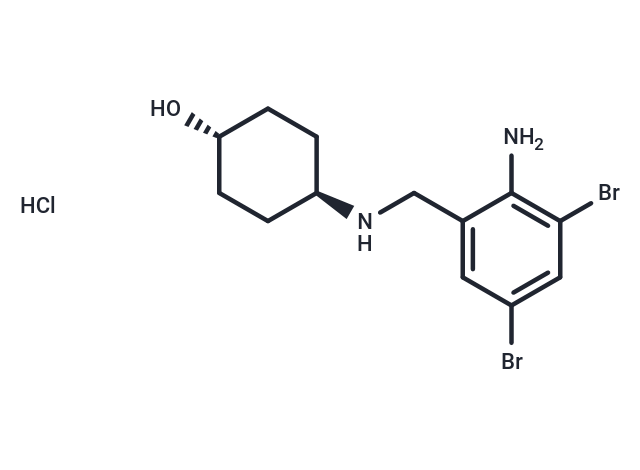Shopping Cart
- Remove All
 Your shopping cart is currently empty
Your shopping cart is currently empty

Ambroxol hydrochloride (Mucosolvan) is a metabolite of BROMHEXINE that stimulates mucociliary action and clears the air passages in the respiratory tract. It is usually administered as the hydrochloride.

| Pack Size | Price | Availability | Quantity |
|---|---|---|---|
| 100 mg | $30 | In Stock | |
| 500 mg | $51 | In Stock | |
| 1 g | $74 | In Stock | |
| 1 mL x 10 mM (in DMSO) | $39 | In Stock |
| Description | Ambroxol hydrochloride (Mucosolvan) is a metabolite of BROMHEXINE that stimulates mucociliary action and clears the air passages in the respiratory tract. It is usually administered as the hydrochloride. |
| Targets&IC50 | Na+ channel:35.2 μM-22.5 μM |
| In vitro | At a concentration of 100 μM, Ambroxol significantly inhibits the release of histamine, LTC4, IL-4, and IL-13 induced by IgE antibodies in basophils, and reduces the release of histamine and LTB4 in monocytes triggered by C5a or yeast polysaccharide. Ambroxol also suppresses the release of histamine by more than 50% in human adenoid hypertrophy (1000 μM Ambroxol) and skin hypertrophy mast cells (100 μM Ambroxol) stimulated by ConA and compound 48/80, respectively. Furthermore, Ambroxol decreases the production of LTB4 and superoxide anion in granulocytes stimulated by yeast polysaccharides or fMLP. |
| In vivo | Ambroxol acts as a charged local anesthetic in CNaIIA cells, exhibiting blockade that is dependent on the number of stimulations and increases with the frequency of a series of depolarizing stimuli. In CNaIIA cells, Ambroxol's inhibition rate for inactivated channels is 5.5 times higher than that for resting channels. Ambroxol differentially affects the kinetics of Na+ currents in TTX-r (tetrodotoxin-resistant) and TTX-s (tetrodotoxin-sensitive) channels, with the response factor for TTX-r channels being only 3.3. Additionally, Ambroxol inhibits Na+ channels in sensory neurons, showing a higher potency in blocking TTX-r channels. Ambroxol also inhibits the release of histamine, leukotrienes, and cytokines from human leukocytes and mast cells. |
| Kinase Assay | Standard HDAC Assays: Rat liver enzyme is diluted 1:6 with HDAC buffer. Recombinant human HDACs are diluted 1:4 in HDAC buffer. For standard HDAC assays, 60 μL of HDAC buffer is mixed with 10 μL of diluted enzyme solution at 30 °C. The HDAC reaction is started by adding 30 μL substrate solution in HDAC buffer followed by 30 min of incubation at 30 °C. The reaction is stopped by adding 100 μL trypsin solutions (10 mg/ml trypsin in 50 mM Tris-HCl [pH 8.0], 100 mM NaCl, 2 μM TSA). After a 20 min incubation period at 30 °C, the release of AMC is monitored by measuring the fluorescence at 460 nm (λex = 390 nm). Fluorescence intensity is calibrated using free AMC. For standard time course experiments, 20 pmol of substrate is used in the initial 100 μL HDAC reaction. Km and Vmax values are determined by measuring the fluorescence AMC generated by enzymatic cleavage of 2–50 pmol of substrate. The experimental data are analyzed using a Hanes plot. The AMC signals are recorded against a blank with buffer and substrate but without the enzyme. |
| Alias | Mucosolvan, Mucoangin, Ambroxol HCl |
| Molecular Weight | 414.56 |
| Formula | C13H18Br2N2O·HCl |
| Cas No. | 23828-92-4 |
| Smiles | Cl.NC1=C(Br)C=C(Br)C=C1CN[C@H]1CC[C@H](O)CC1 |
| Relative Density. | no data available |
| Storage | Powder: -20°C for 3 years | In solvent: -80°C for 1 year | Shipping with blue ice. | |||||||||||||||||||||||||||||||||||
| Solubility Information | DMSO: 50 mg/mL (120.61 mM), Sonication is recommended. | |||||||||||||||||||||||||||||||||||
Solution Preparation Table | ||||||||||||||||||||||||||||||||||||
DMSO
| ||||||||||||||||||||||||||||||||||||

Copyright © 2015-2025 TargetMol Chemicals Inc. All Rights Reserved.